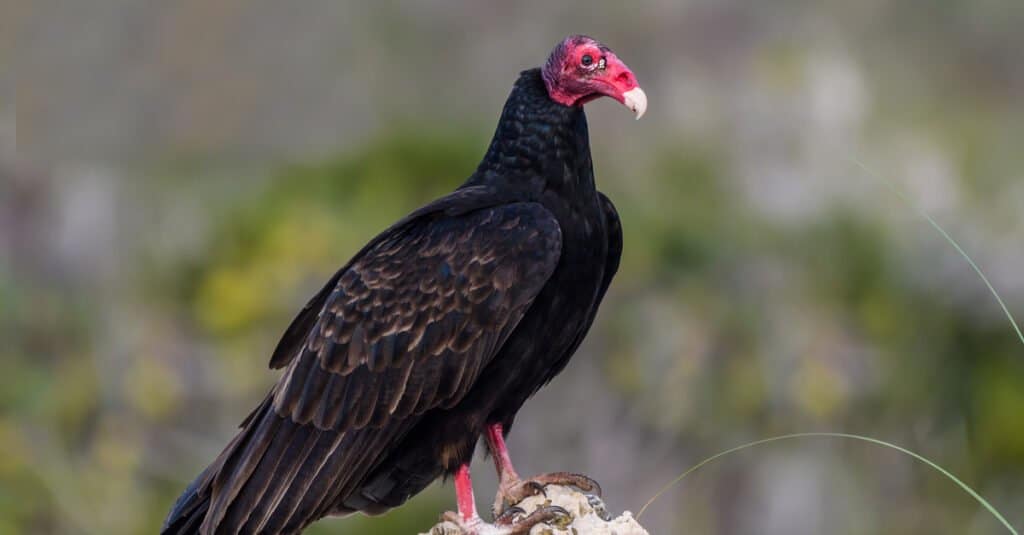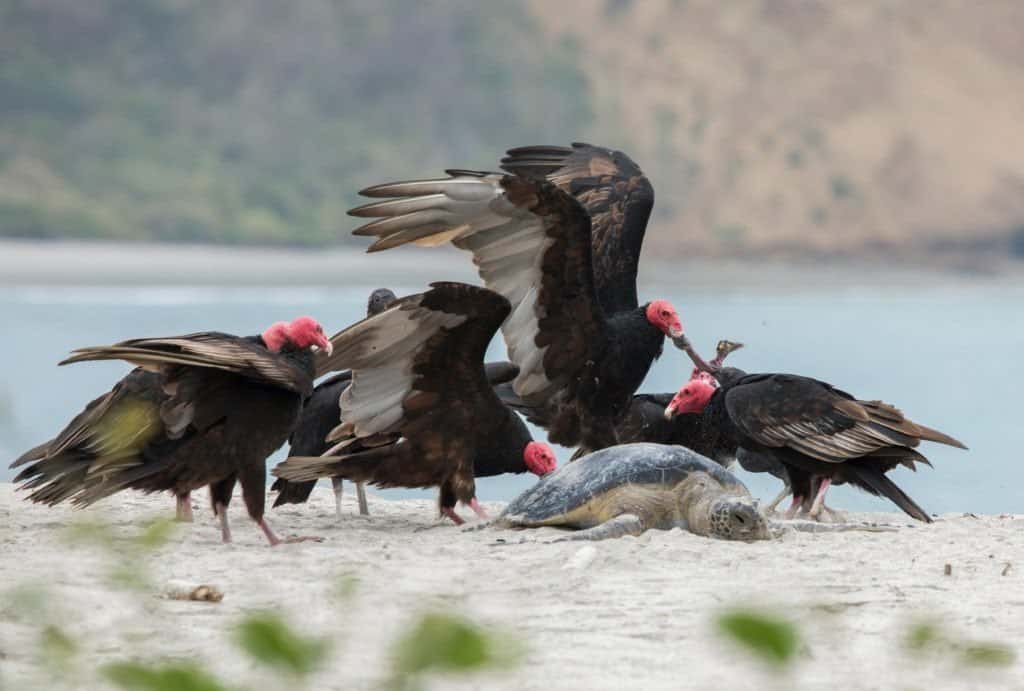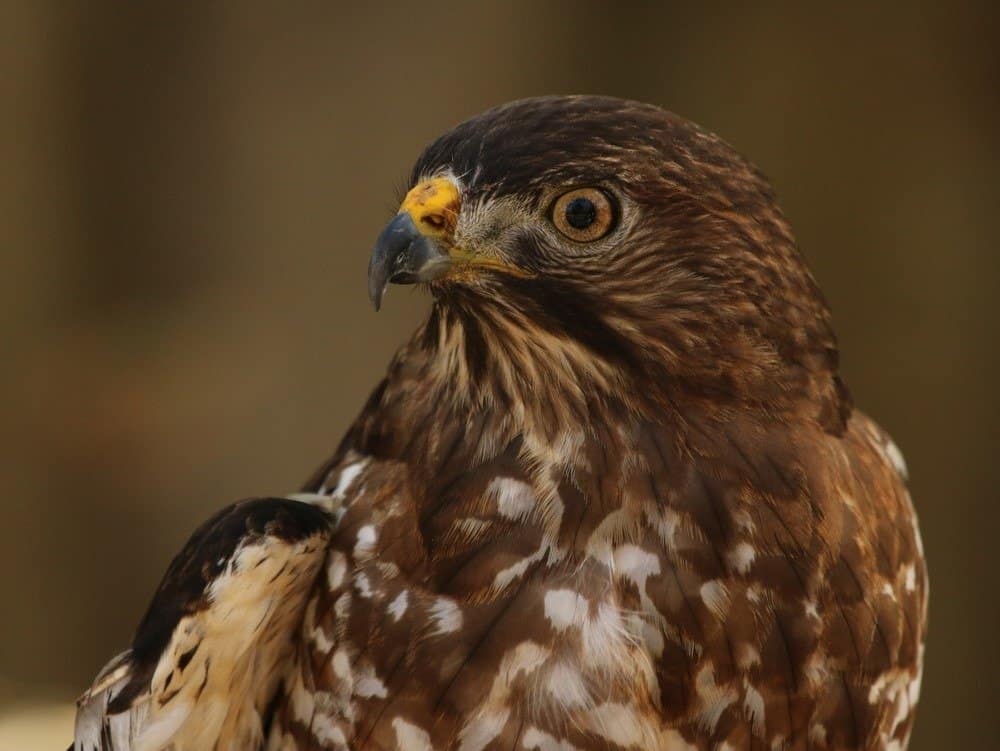Hood-tipped beaks and curved claws called talons are two features that unite all birds of prey. These birds are also known as raptors and are carnivorous creatures that feed on prey that are relatively large for their size. Raptor is a name derived from the Latin word rapio, which means to seize or take by force. However, scavengers like vultures generally wait for someone else to do the seizing by force so they can follow behind and feed on the remains. Let’s take a look at the hawk vs vulture and discover the ways in which these formidable fliers differ.
Comparing a Hawk and a Vulture

| Hawk | Vulture | |
| Scientific Name | Buteo | Cathartes aura |
| Range | North and Central America, West Indies, and Jamaica | Old World Vultures – Europe, Africa, and Asia. New World Vultures – North and South America |
| Habitat | Mountainous plains and tropical, moist areas | Open and semi-open areas, including subtropical forests, shrublands, pastures, and deserts |
| Diet | Small mammals | Carrion |
| Features | Curved bill, sharp talons, red tail | Curved bill, blunt talons, red head |
| Call | Hoarse, screaming “kee–eee–arr” | Occasional hiss or grunt |
The 5 Key Differences Between a Hawk and a Vulture
The main differences between a hawk and a vulture are size, range, habitat, diet, appearance, and call.
A vulture and a hawk are large birds of prey that are popular for their strong beaks, sharp claws, and their ability to soar for a long time. There are quite a number of characteristics that differentiate a hawk from a vulture. We’ll be looking in-depth into some below.
Hawk vs Vulture: Classification

Hawks are part of the
Accipitridaefamily and vultures fall into within the family
Cathartidae.©FotoRequest/Shutterstock.com
Vulture species fall into two broad categories: Old World and New World vultures. The two groups represent carrion-eating birds with similar characteristics, but they are actually distantly related. Vultures are an example of convergent evolution. This is when two groups independently develop similar features and behaviors but are taxonomically different.
Old World vultures are closely related to eagles, hawks, kites, and harries, in the family Accipitridae. Examples include the Egyptian vulture, the Griffon vulture, the European black vulture, the bearded vulture, and the Indian vulture. Some species within the Cathartidae family of New World vultures have an incredibly strong sense of smell that sets them apart. Some examples include the turkey vulture, the California condor, and the Andean condor. The most widespread of the New World vultures is the turkey vulture (Cathartes aura). The genus name Cathartes comes from the Greek word for “cleanser”, referring to its scavenging ways. In this article exploring hawk vs vulture, we’ll narrow our focus to the turkey vulture.
Accipitriformes is the order that includes both the turkey vulture and hawks. From here, they diverge and hawks fall into the Accipitridae family. This family includes hawks, buzzards, kites, harriers, and eagles. It’s broken down into two main groups. The accipitrine hawks include the Gabar goshawk, long-tailed hawk, chanting goshawk, and Doria’s goshawk. The buteo hawks are the second group in this family. They’re called buzzards in places other than North America and are also sometimes referred to as “hawk-buzzards.” We’re focusing on the red-tailed hawk (Buteo jamaicensis), which is a buteo hawk. It’s the most common and recognizable hawk in North America. The species name jamaicensis is in reference to Jamaica, where the bird was first described.
Hawk vs Vulture: Habitat and Range
Turkey vultures are found in open and semi-open areas through the Americas. They take up permanent residence in the southern United States, but northern birds will migrate south as far as Panama. These birds of prey are widespread and abundant. They tend to avoid enclosed forested spaces where it’s more difficult to take flight when they need to. Also, you won’t normally encounter them in treeless areas like wide prairies. They enjoy a sweet spot of open areas near potential nesting and roosting zones, for example, grasslands that are near woodland areas. Turkey vultures are adaptable creatures that can make a home of tropical forests, shrublands, deserts, wetlands, and foothills.
Red-tailed hawks are one of the most common raptor species in the Americas. You can find them in nearly any habitat within North and Central America. Their ideal habitat is similar to that of vultures – mixed forest and field. At woodland’s edge, they enjoy the balance between open space and access to tall trees or high bluffs for nesting and perching. They occupy pastures, deserts, grasslands, coastal and wetland habitats, mountains, foothills, woodlands, and tropical rainforests. These hawks can adapt to urban areas of human development as well.
Hawk vs Vulture: Diet

Vultures prefer carrion while hawks eat small mammals.
©Ana Dracaena/Shutterstock.com
Turkey vultures are primarily scavenging carnivores. They eat the flesh of dead and decaying animals almost exclusively, preferring carcasses that are recently deceased. These birds hardly ever kill the animals themselves but instead take advantage of other predators’ prowess. They locate carrion by its decaying odor over a long distance and circle above it before feeding. Their exceptional sense of smell is uncommon in the bird world.
Dead animals give off Ethyl mercaptan gas produced in the decay process, the same sulfurous compound added to natural gas so that leaks can be detected. Turkey vultures pick up this scent by flying low to the ground. They generally consume the animals before they reach the state of rotting. Turkey vultures play an important part in the ecosystem, disposing of decaying matter before it spreads diseases. Less often, they will eat plant matter, live insects, and fish. Turkey vultures eat in an organized manner called “queuing” at a carcass, in which they each wait their turn for a chance to feast.
Hawks are also carnivores and are extremely opportunistic eaters that may consume almost any small animal they encounter. Small mammals like rodents are their most common prey, making up roughly 85% of their total diet. Hawks will eat mammals as large as cottontail rabbits. Reptiles, fish, amphibians, and other birds make up the rest of their diet.
Red-tailed hawks often hunt from perches – a common technique used for surprising prey. It’s also their most successful hunting practice. These hawks will also cruise over their prey with flap-and-glide flight, especially when catching small birds. Hawks play an important role in their ecosystems by helping to control the populations of small mammals. They also provide habitat for some bird species like the house sparrow that lives in hawk nests.
Hawk vs Vulture: Appearance
Red-tailed hawks vary in color with some light and some dark-colored individuals. Typically, they have darker heads than their bodies and are identifiable by their characteristically red tail. These hawks have dark streaks on their belly that make up a “belly band.” Males and females of this species are similar in appearance. Their size averages 1.5 to 3.5 lbs, 18-26 inches in body length and they have a 43-55 inch wingspan. Hawks have strong feet, razor-sharp talons, and a hooked bill. They possess exceptionally keen vision, allowing them to identify prey at great distances away.
Turkey vultures are large, darkly colored birds with broad wings. They have distinctive featherless, redheads and a pale bill. They aren’t able to easily kill prey or to tear at a carcass with more than their sharp, curved beak. This is due to having very weak feet and blunt talons. On average, they are 1.8-5.3 lbs, 24-32 inches in length, and have a 63-72 inch wingspan. When soaring, they hold their wings slightly raised, appearing as a “V” when seen head-on.
Hawk vs Vulture: Communication

Vultures are silent types who occasionally grunt or hiss, but hawks have loud, screeching calls.
©Julie rubacha/Shutterstock.com
Adult red-tailed hawks have their impressive, easily-identified calls. They come out as loud, hoarse “kee–eee–arrr’s” and are often compared to the scream of a steam whistle. Red-tailed hawks display many aerial behaviors. They have a sky-dance known as the talon-drop which happens during courtship. During this ritual, they swoop down and try to touch one another with their talons. They exhibit territorial displays of up-and-down movements called an undulating flight, and steep dives meant to be shows of their strength, agility, and prowess to protect their areas.
Turkey vultures are generally silent creatures but they’ll hiss or grunt when they feel threatened. They’re pretty timid birds who will regurgitate their meal for another to consume if threatened at a carcass by a fellow scavenger. This is actually the way they respond to most threats – by vomiting. Their vomit is generally an acidic slurry of flesh from dead animals, so vomiting at the source of their threat usually works to prevent further aggression. Turkey vultures mate for life and have a unique method for courtship display in which they gather in a circle on the ground and perform ritual hopping movements around the circle with their wings spread, followed by long flights by the males.
Hawk vs Vulture: Behavior
Red-tailed hawks are monogamous, diurnal creatures who will mate for life but are relatively solitary aside from breeding season. Occasionally, they do form large flocks and take advantage of rising thermal air currents, but often fly alone. These raptors typically build their nests in the crowns of tall trees and other structures where they can have an overarching view of the landscape. They may or may not use the same nest annually. Sometimes a pair will have a few nests in the area and construct a couple for the breeding season before they settle into one of them to lay their clutch of 1-4 eggs.
Turkey vultures carry a bad reputation for their strange appearance and penchant for death but they are actually extremely social birds. They roost in large, communal groups and maintain these locations over time, often for many generations. Small groups of foraging turkey vultures will often perch together on a tree or roof forming a group called a “wake.” Large flocks of birds will fly together actively foraging. These swirling flocks resemble heated water boiling in a pan, and are referred to as “kettles.” Often they nest at locations near the communal roost, but these “nests” typically aren’t constructed forms. They take advantage of suitable sites on the ground like caves, hollow logs, stumps, or dense masses of vegetation where they can push matter aside to lay their clutch of 1-3 eggs. Once they choose these sites, they often use them for a decade or more.
The photo featured at the top of this post is © Ondrej Prosicky/Shutterstock.com
Thank you for reading! Have some feedback for us? Contact the AZ Animals editorial team.






